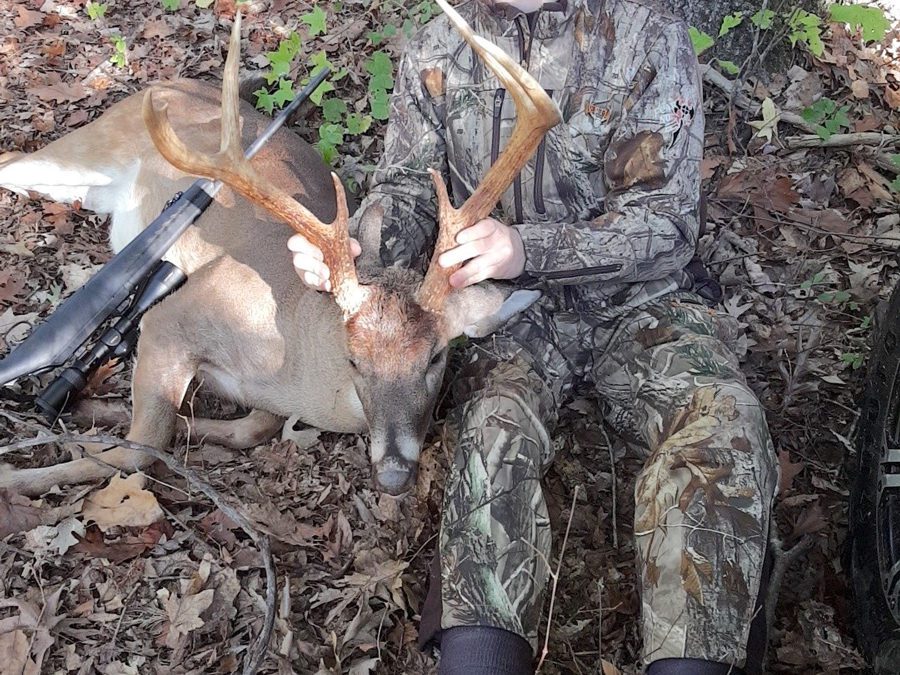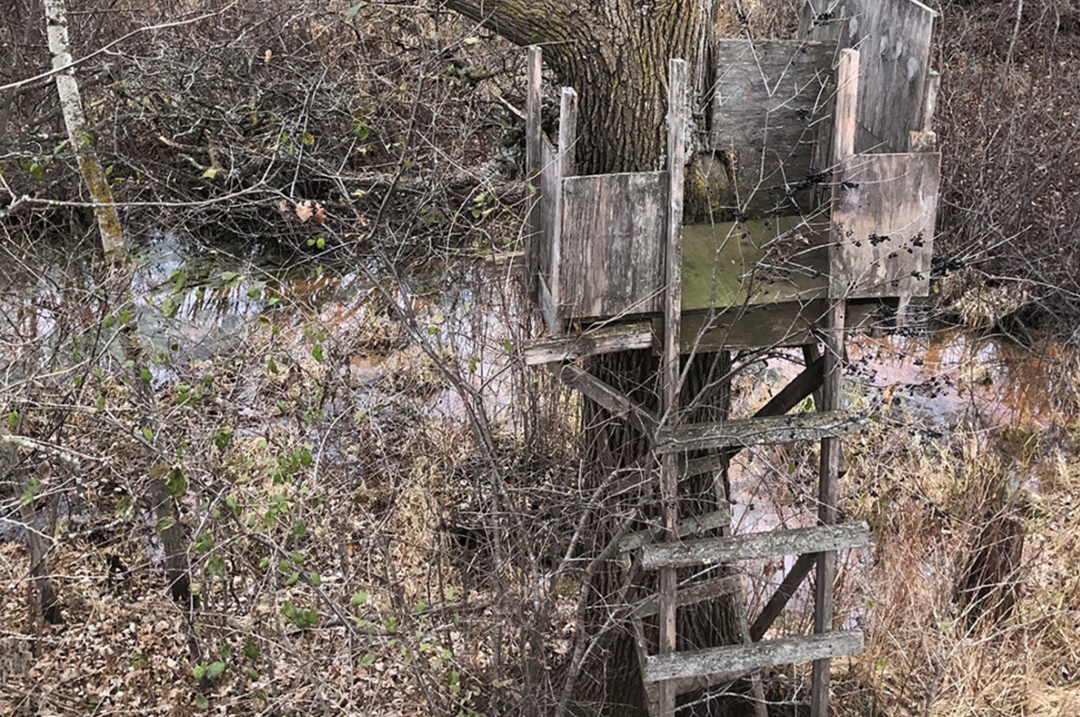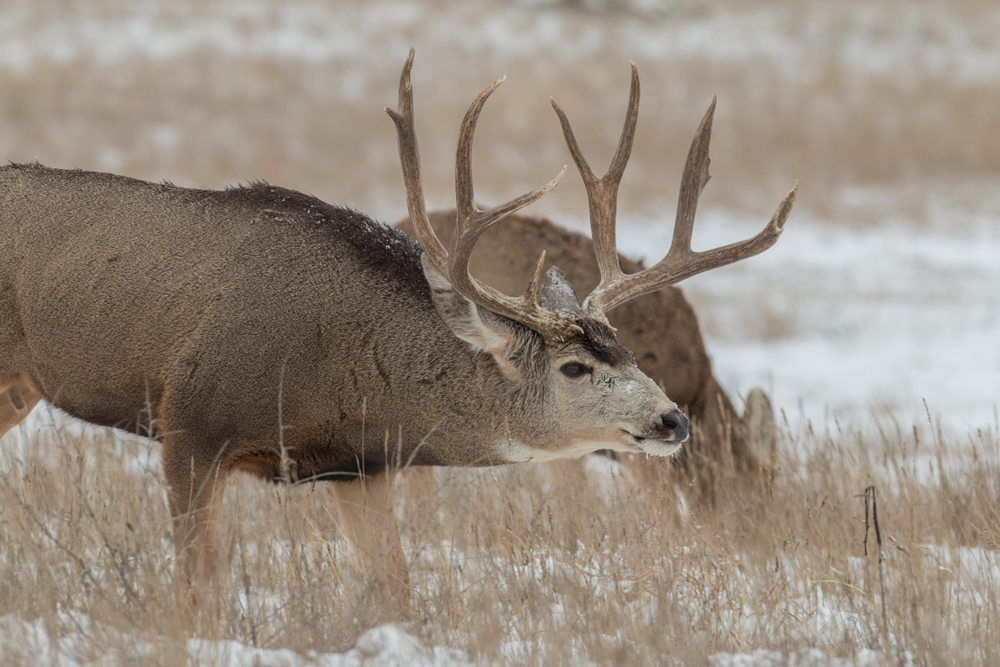Nothing, not even a crippling fall from a deer stand, was going to deter Aaron Summitt from going after the buck with the sky-high antlers than he had been chasing for the last two years. Sitting on his four-wheeler, his legs encased in hard casts, Summitt was watching a doe about 100 yards away when a buck walked out behind her.
“He moved his head, and I recognized him right away,” Summitt said.
The big-bodied 6-point sported main beams that reached high above his head, almost like the rack of a caribou. Summitt nudged his girlfriend, Brittney Muto, and said, “There he is.”
“I saw the doe first and then looked a little to the right. All I could see were horns,” Muto said.
Summitt raised the Ruger American .243 rifle and waited a long minute for the buck to step out from behind a bush, then made a solid shot.
Muto, also an avid deer hunter, followed the blood trail and found the buck a short distance into the woods. The buck weighed 185 pounds, and a preliminary measurement of the rack totaled 123 inches. The main beams are 22 inches long, and they are thick—both are five inches in circumference at the base. The inside spread is 17 inches, while the outside spread is 19 inches with 14 inches between the tips. The G2s are both eight inches long.
The rack is remarkable due to the upsweep of the main beams, but more remarkable is the fact that Summitt was able to even make the hunt. By all standards, the 23-year-old Chester, South Carolina, deer hunter should have been in a hospital bed at the very least, perhaps paralyzed—or even dead.
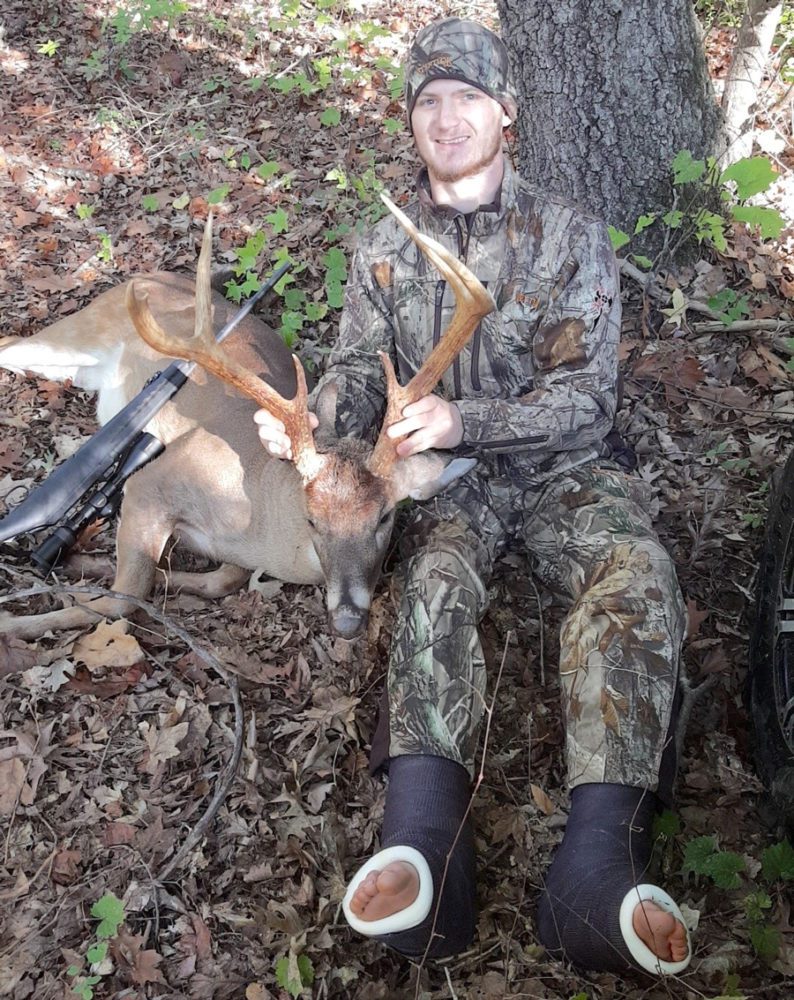
He shot the buck on the morning of October 20, less than six weeks after falling 30 feet from his bow stand, shattering his ankles and legs and injuring his back.
According to the Tree Stand Safety Awareness Foundation, a hunter falling from that height could be traveling at 30 miles per hour when he hits the ground. Treestand falls are the biggest risk that whitetail deer hunters face, greater even than injuries due to firearms. Falls are very serious, sometimes resulting in paralysis, traumatic brain injury, or death.
The fall occurred in Chester County the afternoon of September 10, five days before the opening of bow season in South Carolina’s Game Zone 2. Although Summitt shot the buck with the sky-high antlers with a rifle, he lives and breathes bowhunting. But he could not climb to his bow stand following the injury.
Summitt and Muto were deep in the woods putting up two lock-on stands on the same tree. Both planned to hunt from that tree when archery season opened five days later.
“I noticed one of my straps had a tear in it, so I got down to get another strap and climbed back up in the stand. I was tightening the new strap when the other strap broke—and I fell 30 feet to the ground,” Summitt recalled.
He can still hear the sound of that strap breaking—“a loud, bone-chilling snap with metal clanging at the same time. Just a unique sound you don’t ever want to hear in a deer stand.”
As he pitched away from the tree, Summitt desperately tried to reach out and catch hold of something to stop his fall, but all he grabbed was air. The time from the sound of the snap to the impact as his feet hit the ground took only a second, though it seemed like it was happening in slow motion, Summitt said.
“In that second I knew what was going to happen, knew it was going to hurt,” he said. “I just hoped the result would not be as bad as it could be.”
He landed on his legs, standing straight up, then crumpled to the ground. He stood back up and tried to walk towards Brittney, but his ankles caved in and he fell forward on his stomach.
“I knew I had to get out of there,” he said.
Oh my God! The exclamation rattled Brittney’s thoughts as she watched Summitt plunge to the ground. She ran towards him, but it seemed she was moving in slow motion.
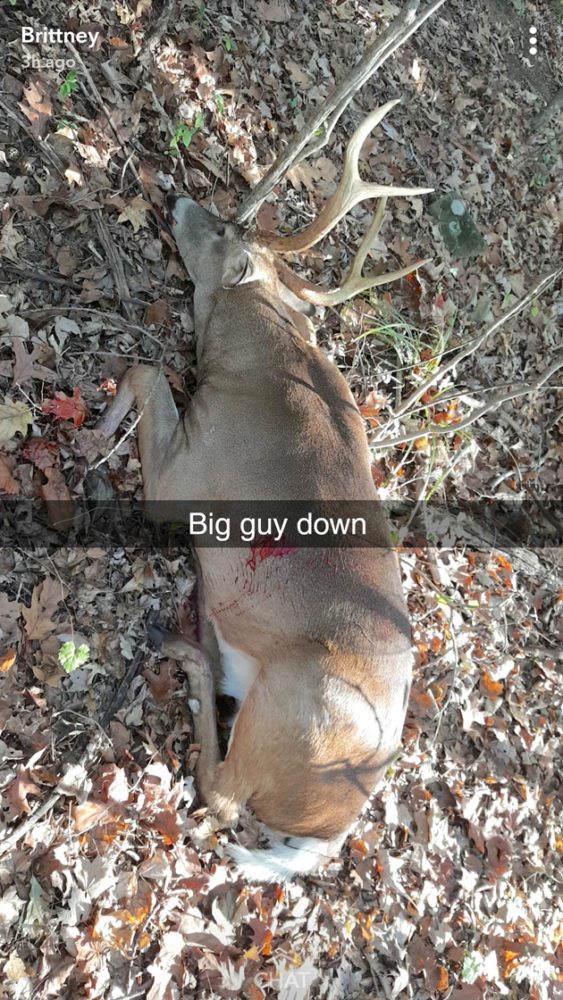
“After he tried to stand up, he told me his legs were broken and his back was broken. He wanted me to get his boots off because he knew his feet would swell. When I pulled his boots off, I could feel the bones. I could see bones almost protruding out of the skin.”
Other hunters in the club who were preparing their stands and hunt areas for the opening of archery season came to assist. A frantic call to 911 got help on the way, but it would take several hours for emergency personnel to hack and cut their way through the woods with chainsaws to get to Summitt. During that time Muto did her best to comfort him, cradling his head in her lap while waiting on the rescue crew to get to them.
“She was there to calm me down. If she had not been there, I would have been freaking out,” Summitt said.
Muto said the feeling was mutual.
“I was just trying to keep him comfortable, rubbing his chest, talking to him,” she said. But it was not easy, and at one point she almost lost it. Summitt’s color began to take on a purple hue.
“I almost panicked, but Aaron said, ‘You can’t.’ So I just sat there and kept telling him, ‘You are going to be fine.’”
Three hours after the fall, he was finally in the hospital in Charlotte, North Carolina, where he underwent two hours of surgery to try to stabilize some of the broken bones.
“The next morning they came in and told me what all was broken in my back, legs, ankles, and heel. That ‘s when I realized my condition was not as bad as it could have been. I actually knew that from the time I hit the ground and realized I could still wiggle my fingers and toes.”
His legs from the knees down were shattered, his right ankle broken into a dozen pieces. The L3 vertebra in his back was broken. His right leg was broken in 12 places and doctors had to fuse his right ankle. He is literally being held together with pins, screws, and metal rods. Both legs are in casts.
Luckily, he did not have to have any surgery on his back. After several months of recuperation, he will begin rehabilitation after the first of the year to get back on his feet and start walking again.
Meantime, he and Muto have become vocal advocates for treestand safety.
“I will tell hunters they have to have safety harnesses,” Summitt said. “Even if you are careful, it will happen, so hopefully if you fall you will have a harness on.”
Ironically, Summitt was a harness user, but that afternoon he did not have one on.
“I just planned to climb up real quick to replace that strap, but that is when it is going to happen. You don’t think about it, but it will happen, so take that extra precaution. Put a safety harness on. Make sure you do all you can to prevent a fall.”
“A lot of people don’t think they need a harness,” Muto added, “but anything can happen. Aaron is a prime example of that.”
Despite the fall, Summitt plans to be back in his bow stand when archery season opens next fall. Muto isn’t waiting.
“We’ve got Aaron’s buck in the freezer, but I know one deer is not going to do us for the year. I’ve been back out a few times. I want to get a mature doe, just to get meat in the freezer, but if a good buck walks by I am not going to let him go.”
The ABCs of Treestand Safety
The Tree Stand Safety Awareness Foundation, in cooperation with Realtree, has designed an educational campaign to guide hunters toward the safe use of treestands. The ABCs are:
Always remove and inspect your equipment.
Buckle on your full-body harness.
Connect to the tree before your feet leave the ground.

